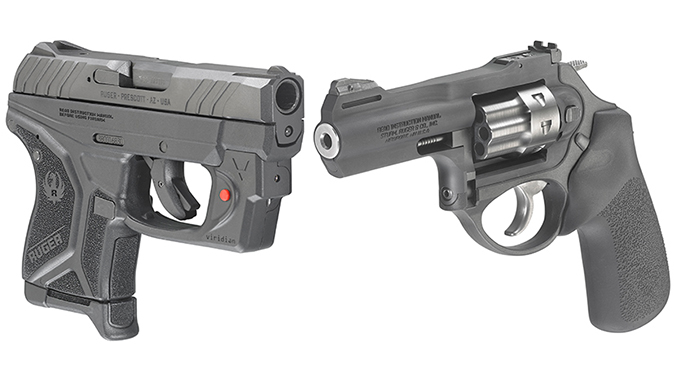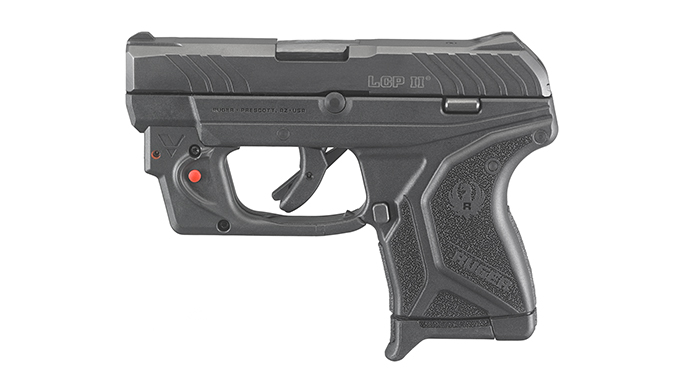Sturm, Ruger & Company’s product line includes something for just about every type of shooter. The company produces single-shot, bolt-action and semi-auto rimfire and centerfire rifles, rimfire and centerfire revolvers, semi-automatic pistols and over/under shotguns. I have heard it said that if a shooter “can’t find what they need in Ruger’s catalog, they’re in a lot of trouble!”
The Semi-Auto
Ruger broke into the CCW pistol market in 2008 with the introduction of its Light Compact Pistol (LCP). It was a radical departure from the company’s previous efforts in this area. Despite being chambered for the .380 ACP cartridge, it was smaller and lighter than some .22-, .25- and .32-caliber pistols. The LCP is based upon a glass-filled nylon frame with alloy inserts to provide additional strength and rails for the slide to reciprocate on. The slide itself is machined from hardened steel and features a blued finish.
Advertisement — Continue Reading Below
As has become almost mandatory with polymer-framed handguns today, the LCP features a double-action-only (DAO) trigger. This not only provides for simple operation—a feature I consider of the utmost importance on any firearm intended for personal protection—but also provides the traditional safety features of a DA revolver, allowing operation without the necessity of manipulating external safety devices. The gun utilizes an internal hammer, which I feel is more reliable than a striker on subcompact pistols.
The LCP uses a “single-strike” trigger, which means that if you have a misfire or are dry firing an empty pistol for practice, it is necessary to partially retract the slide to reset the hammer before you can pull the trigger again. The LCP’s other controls are conveniently located, with the magazine release button in the “proper” position. The slide catch, located above the left grip panel, can be used to lock the slide open, providing a convenient means of cleaning the gun or verifying that the chamber is empty.
Advertisement — Continue Reading Below
The LCP proved a popular item for concealed carry by licensed civilians. It also proved popular as a backup or off-duty weapon with law enforcement officers. But Ruger is well known for constantly improving its products, and the company recently introduced the LCP II.
This pistol features larger sights, an improved double-action-only (DAO) trigger pull, dual grasping grooves on the slide and a newly textured grip frame. A blade-style safety in the face of the trigger combines with a neutrally balanced sear with significant engagement and strong spring tension and a hammer catch to help prevent the hammer from contacting the firing pin unless the trigger is pulled through a complete stroke.
Shortly before the 2017 NRA Annual Meetings & Exhibits, Ruger announced two new handguns for concealed carry. The first was a version of the LCP II with an integral Viridian E-Series red laser. This unit is located on the front of the pistol’s triggerguard and features ambidextrous off/on buttons that can be activated by the shooter’s trigger finger. Despite only adding 1.4 ounces to the pistol’s weight, it cannot be used with holsters designed for the standard LCP II due to its size and location. Because of this, Ruger thoughtfully includes an inside-the-pocket holster with each pistol.
Advertisement — Continue Reading Below
The Wheelgun
The second handgun is an addition to Ruger’s already extensive line of LCR revolvers—the LCRx.
In 2009, Ruger introduced a very unique wheelgun, the .38-caliber Light Compact Revolver, or LCR. It was composed of three modular subcomponents: an upper cylinder frame/barrel assembly, a lower-frame “fire control housing” (FCH) assembly and a cylinder/crane assembly.
Advertisement — Continue Reading Below
The cylinder/frame/barrel assembly consisted of a 7400 series aluminum forging, which served as a housing for the cylinder/crane assembly and the cylinder release catch. A stainless steel barrel is threaded into the barrel shroud.
The dual-diameter cylinder not only sets the LCR apart from other revolvers on the market, but provides additional strength around that section of the chambers where pressures are the highest. Pressing a button on the left behind the cylinder allows shooters to push the cylinder out for loading and unloading. Cylinder locking is accomplished by latching the cylinder center pin into a steel bushing in the recoil shield and a spring-loaded pin in the ejector rod shroud engaging the front of the rod.
All of the moving parts, other than the cylinder release catch, are contained in the FCH. The FCH is constructed from high-density glass-filled nylon. The LCR also uses an internal hammer and a DAO trigger. This unit uses a patented interface between the trigger and hammer. A small friction-reducing cam on the toe of the trigger positions the two parts so that they operate in tandem when the trigger is pulled, rather than resisting each other, as has been the norm in all earlier DA revolver trigger systems.
Advertisement — Continue Reading Below
LCR revolvers also feature transfer bar ignition. When forward, the hammer rests upon the frame and cannot touch the frame-mounted firing pin. A complete stroke of the trigger raises a bar in front of the firing pin that the falling hammer strikes. This drives the firing pin forward to fire the cartridges. Releasing the trigger allows the bar to drop down, leaving the hammer to rest on the frame once more.
Ruger expanded the LCR line to include .22 LR, .327 Federal Magnum, .357 Magnum and 9mm chamberings. While popular, the LCR’s short 1.88-inch barrel and DAO trigger limited its usefulness to close-range shooting. To rectify the situation, in late 2013 Ruger introduced the LCRx revolver with a 3-inch barrel and an external hammer (that’s where the “x” comes in) so that it can be cocked for precise SA shooting. The gun also comes standard with a hand-filling Hogue Tamer Monogrip that provides adhesion whether your hands are wet, dry or oily as well as a ramp front sight with a white insert and a fully adjustable rear for better accuracy at longer distances.
Range Testing
Advertisement — Continue Reading Below
One of the newest additions to Ruger’s LCR series is the LCRx in .22 LR. I feel this is a multitasking revolver capable of being used for plinking, training and small-game hunting. And thanks to its unloaded weight of only 17.3 ounces, even concealed carry.
Ruger kindly supplied me with sample of each of these new handguns to test for our readers. The LCP II was a dainty little thing, probably the smallest .380 ACP pistol I’ve ever held. The Viridian laser sight was easily activated and produced a bright red dot on the target, even in full daylight.
Advertisement — Continue Reading Below
Before the accuracy testing, I ran two magazines each of five different types of .380 ACP ammo through the little Ruger LCP II: Hornady 90-grain FTXs, Winchester 95-grain Defend JHPs, Browning 95-grain X-Point JHPs and Black Hills’ 100-grain FMJs and 60-grain Xtreme Defense rounds. I’m pleased to relate that I only experienced a single malfunction when one of the Browning JHPs hung up on the feed ramp. Other than that, the petite Ruger semi-auto chugged right along with everything I fed it.
As I believe that attempting to shoot tight groups off a rest with a pistol of this class is not a practical test of its accuracy (to say nothing of an exercise in futility), my test firing was limited to engaging a combat target at 5 yards. I fired the pistol from a low position with the laser sight. With the pistol’s attenuated grip, the recoil was on the snappy side. Once I had the hang of it, however, all but two of the 24 rounds I sent in the direction of the target impacted inside the 9 and 10 rings.
Because of its SA trigger, longer barrel, larger grip and nice sights, I tested the LCRx for accuracy from an MTM K-Zone rest at 15 yards. The LCRx produced five-shot groups running from a bit under 3 inches to an impressive 1.3 inches with Eley ammo. After this informative, albeit unexciting, expenditure of .22 LR ammunition was completed, we set up a combat target. My wife, Becky, proceeded to run some off-hand drills from 7 yards. She had to nurse the heavy DA trigger along, but with the perseverance that she is well known for, she put all but three rounds inside the 10 ring.
Advertisement — Continue Reading Below
We then placed a pair of Birchwood Casey Prairie Chuck targets out at 30 feet and proceeded to see how the .22 LR revolver would serve for small-game hunting or as a trail gun. Once again, the Ruger proved to be a fine-shooting wheelgun and showed us that it was equally capable of turning critters into camp meat if called up to perform such a task.
Fit For Ruger
We found both of Ruger’s newest products to fit the tasks they were designed for to a “T.” If you are looking for an ultra-concealable, subcompact .380 ACP for concealed, the LCP II with the Viridian laser sight would be an ideal choice. If wheelguns are more your forte, then the LCRx is an obvious contender. Its light weight, easy handling characteristics, simplicity of operation and lack of recoil would be perfect for a multitude of tasks, including—you guessed it—concealed carry. And the low cost of .22 LR ammo allows the shooter to get in plenty of practice, something that can’t be said for centerfire calibers.
Admittedly, the .22 LR would not be my first choice for defensive use. But we should remember the old saying “The best gun is the one you have with you.” Or as a local police officer I know who packs a snub-nose .22 in an ankle holster as a backup once said to me, “I don’t know anyone who wants to be shot with a .22. Do you?”
Ruger LCP II With Viridian E-Series Laser Specs
| Caliber: .380 ACP |
| Barrel: 2.75 inches |
| OA Length: 5.17 inches |
| Weight: 11.4 ounces (empty) |
| Grips: Glass-filled nylon |
| Sights: Fixed |
| Action: DAO |
| Finish: Blued |
| Capacity: 6+1 |
| MSRP: $439 |
Ruger LCRx Specs
| Caliber: .22 LR |
| Barrel: 3 inches |
| OA Length: 7.5 inches |
| Weight: 17.3 ounces (empty) |
| Grip: Hogue Tamer Monogrip |
| Sights: Blade front, adjustable rear |
| Action: DA/SA |
| Finish: Matte black |
| Capacity: 8 |
| MSRP: $579 |
For more information, visit ruger.com.






































